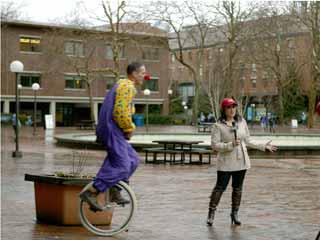Sydney’s best street performers
http://www.cnngo.com/sydney/life/sydney-street-performer-busk-move-693315
Here is the text:
Sydney’s best street performers
From the harbor to underground tunnels, here’s where to find Sydney’s most change-worthy extroverts.
By Mitchell Jordan
11 March, 2011
Street performance by Mr Incredibubble, Hyde ParkNear St. Mary’s Cathedral, Mr. Incredibubble proves that busker bubbles are not easily burst.
Walking the streets of Sydney can feel like walking through an episode of “Australia’s Got Talent.” Some performers seem positively desperate for a chance at fame, while other buskers are just trying to pay the rent.
Sydney’s street performers may not have to endure the demoralizing criticism of Kyle Sandilands, but they do have to audition before being granted a busking license.
Licenses granted by the City of Sydney Council or state government agencies give performers two-hour slots at “busking spots.”
Of course, many red-tape-averse buskers just set up and drop their daks for a dollar.
Here’s a fast review of some of the places and street characters who have qualified in the city’s busking auditions.
Hyde Park:
Justin Maloney, better known as Mr. Incredibubble, blows human-sized bubbles from his own secret potion.
He is as much a part of the Hyde Park furniture as the benches, but there’s no way you’ll catch him singing.
“There’s too many musos out there already,” Mr. Incredibubble says. “I can play a few instruments, but only standard nursery rhymes.”
[B]Circular Quay:
Street performer Jamey Mossengren: For some performers, no spotlight is big enough.
At Circular Quay, Jamey Mossengren rides on a 12-foot unicycle while juggling knives and fire.
During two years of performances, nobody’s been hurt, meaning experience from his previous job – in a medical corporation – hasn’t been called upon.
“(My corporate job) was like being in jail from Monday to Friday,” Mossengren says. “Now I’m not rich, but at least I’m my own boss.”
He competes against the ever-present didgeridoos and theatrical types that line the ferry wharves.[/B]
Pitt Street Mall:
The three guys behind the rock band Night Owl busk several times a week at the recently opened Westfield on Pitt Street.
The gig has yet to earn them the perks of a high-flying rock-and-roll life.
“We make a meager living,” says guitarist, Daniel D’Arcy. “We just scrape by when it comes to paying the rent.”
They say the shopping mall is one of the better busking places, but they also play at Town Hall Station.
"The CityRail station manager told us we could play there because he likes us,” says banjo player, Matt Mason.
Town Hall:
The adrenaline-pumped skipping and dancing moves of Double Dutch team, Kanpai, draw a strong crowd outside Town Hall.
The trio, Mai, Aki and Kazuma – each in their twenties – met at a skipping club in Japan. From there, they competed in the Double Dutch Challenge in Kobe.
Now living in Australia, they support themselves through one-hour performances most days.
“Sydney is good for busking,” says Mai.
Central Station Tunnel, Broadway:
In Central Tunnel, just off Broadway, expect to hear buskers cranking out popular power ballads. The tunnel is packed with commuters during peak hours.
Twenty-year-old student, Rachael Helmore, plays her three-stringed guitar and flute regularly. The way to a listener’s wallet, she reckons, is by playing the Super Mario theme intertwined with Tetris-sounding music on the flute.
“Guys especially love that one,” she says, adding that John Lennon’s “Imagine” is another reliable change magnet.

 Bet that got some readers wondering if he needs another wheel!
Bet that got some readers wondering if he needs another wheel!